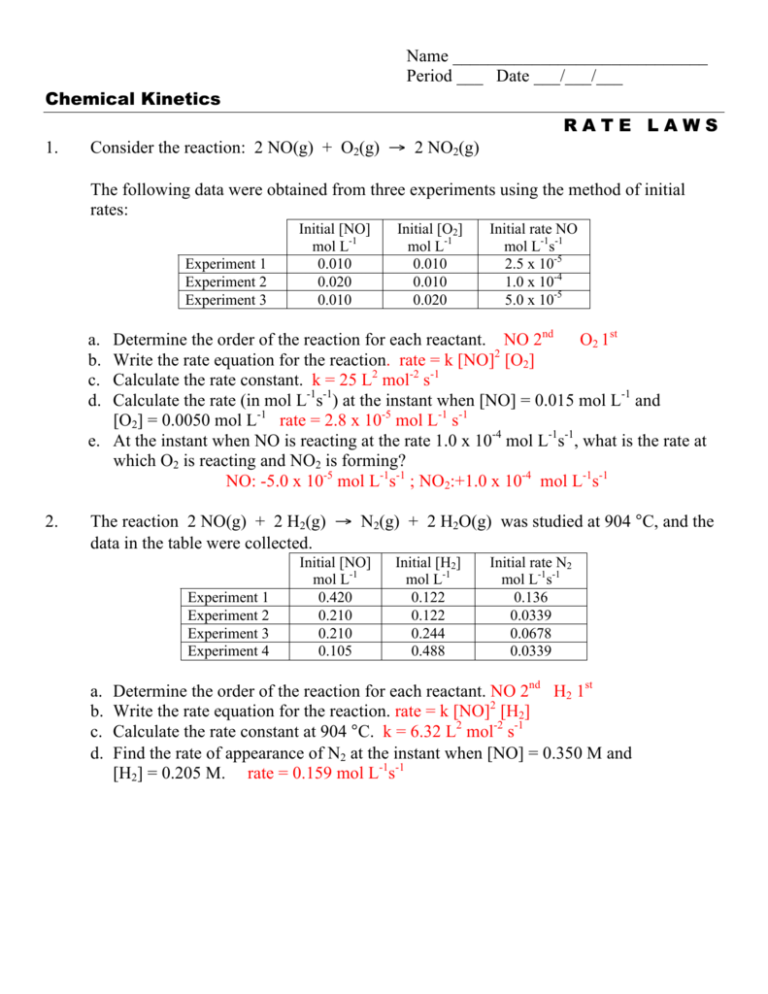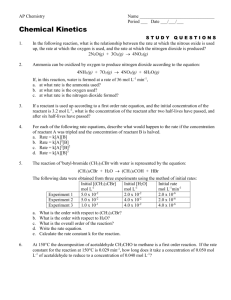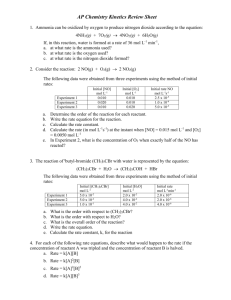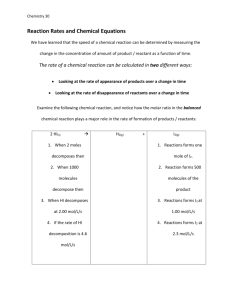Rate Law Worksheet 2
advertisement

Name _____________________________ Period ___ Date ___/___/___ Chemical Kinetics RATE LAWS 1. Consider the reaction: 2 NO(g) + O2(g) → 2 NO2(g) The following data were obtained from three experiments using the method of initial rates: Experiment 1 Experiment 2 Experiment 3 Initial [NO] mol L-1 0.010 0.020 0.010 Initial [O2] mol L-1 0.010 0.010 0.020 Initial rate NO mol L-1s-1 2.5 x 10-5 1.0 x 10-4 5.0 x 10-5 Determine the order of the reaction for each reactant. NO 2nd O2 1st Write the rate equation for the reaction. rate = k [NO]2 [O2] Calculate the rate constant. k = 25 L2 mol-2 s-1 Calculate the rate (in mol L-1s-1) at the instant when [NO] = 0.015 mol L-1 and [O2] = 0.0050 mol L-1 rate = 2.8 x 10-5 mol L-1 s-1 e. At the instant when NO is reacting at the rate 1.0 x 10-4 mol L-1s-1, what is the rate at which O2 is reacting and NO2 is forming? NO: -5.0 x 10-5 mol L-1s-1 ; NO2:+1.0 x 10-4 mol L-1s-1 a. b. c. d. 2. The reaction 2 NO(g) + 2 H2(g) → N2(g) + 2 H2O(g) was studied at 904 °C, and the data in the table were collected. Experiment 1 Experiment 2 Experiment 3 Experiment 4 a. b. c. d. Initial [NO] mol L-1 0.420 0.210 0.210 0.105 Initial [H2] mol L-1 0.122 0.122 0.244 0.488 Initial rate N2 mol L-1s-1 0.136 0.0339 0.0678 0.0339 Determine the order of the reaction for each reactant. NO 2nd H2 1st Write the rate equation for the reaction. rate = k [NO]2 [H2] Calculate the rate constant at 904 °C. k = 6.32 L2 mol-2 s-1 Find the rate of appearance of N2 at the instant when [NO] = 0.350 M and [H2] = 0.205 M. rate = 0.159 mol L-1s-1 3. The reaction of tbutyl-bromide (CH3)3CBr with water is represented by the equation: (CH3)3CBr + H2O → (CH3)3COH + HBr The following data were obtained from three experiments using the method of initial rates: Experiment 1 Experiment 2 Experiment 3 a. b. c. d. e. 4. Initial [(CH3)3CBr] mol L-1 5.0 x 10-2 5.0 x 10-2 1.0 x 10-1 Initial [H2O] mol L-1 2.0 x 10-2 4.0 x 10-2 4.0 x 10-2 Initial rate mol L-1min-1 2.0 x 10-6 2.0 x 10-6 4.0 x 10-6 What is the order with respect to (CH3)3CBr? 1st What is the order with respect to H2O? 0th What is the overall order of the reaction? 1 + 0 = 1 Write the rate equation. Rate = k [(CH3)3CBr] Calculate the rate constant, k, for the reaction. 4.0 x 10-5 The reaction: 2 NO2(g) + O3(g) → N2O5(s) + O2(g) Rate Law: Rate = k [NO2]1 [O3]1 Determine the initial rate for each of the following experiments if the rate constant, k, is 6.50 x 104 M-1 s-1. Experiment 1 Initial [NO2] mol L-1 0.100 Initial [O3] mol L-1 0.200 Initial rate mol L-1min-1 1300 Experiment 2 0.100 0.100 650 Experiment 3 0.200 0.400 5200









